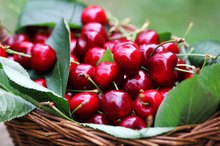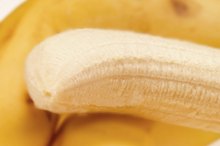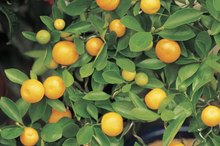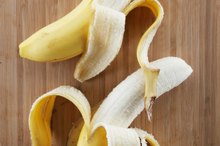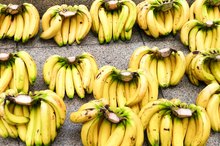What does fact checked mean?
At Healthfully, we strive to deliver objective content that is accurate and up-to-date. Our team periodically reviews articles in order to ensure content quality. The sources cited below consist of evidence from peer-reviewed journals, prominent medical organizations, academic associations, and government data.
The information contained on this site is for informational purposes only, and should not be used as a substitute for the advice of a professional health care provider. Please check with the appropriate physician regarding health questions and concerns. Although we strive to deliver accurate and up-to-date information, no guarantee to that effect is made.
Foods Rich in Fiber & Potassium
Dietary fiber and potassium are nutrients required by the human body to maintain optimal health. Fiber comes from the parts of plant foods that are not digested by enzymes in the intestines. Instead, fiber adds bulk to the stool, and helps move solid waste easily from the body. Potassium helps conduct electricity in the body, plays a role in skeletal and muscle function, and maintains heart and lung function. Many foods contain one nutrient or the other, but only a few are rich in both fiber and potassium. Fruits, vegetables and a few legumes and grains are the best sources of the two nutrients in single foods.
Fruits
Many different fruits contain rich amounts of both fiber and potassium. A medium banana, for example, contains about 3.1g total fiber, according to MayoClinic.com, and approximately 480mg potassium 1. Other fruits high in both of theses essential nutrients include:
- oranges
- raspberries
- pears
- apples
- strawberries
- figs
- raisins
- apricots
- tomatoes
One medium-sized tomato contains about 292mg potassium, and 1.5g fiber. Fruits eaten with their skins, where possible, generally provide more fiber than peeled fruits.
- Many different fruits contain rich amounts of both fiber and potassium.
- Fruits eaten with their skins, where possible, generally provide more fiber than peeled fruits.
Vegetables
Red Cherries & Potassium
Learn More
The richest sources of potassium in the diet are fruits and vegetables, according to the Linus Pauling Institute at Oregon State University 23. Many vegetables also contribute largely to the intake of dietary fiber. One medium potato, baked with its skin, provides about 2.9g fiber and approximately 926mg potassium. Other vegetables that contain significant amounts of both fiber and potassium include:
- artichokes
- winter squash
- acorn squash
- peas
- broccoli
- sweet potatoes
As with fruits, unpeeled vegetables also provide more fiber than those with skin removed.
- The richest sources of potassium in the diet are fruits and vegetables, according to the Linus Pauling Institute at Oregon State University 2.
- Other vegetables that contain significant amounts of both fiber and potassium include: * artichokes
* winter squash
* acorn squash
* peas
* broccoli
* sweet potatoes As with fruits, unpeeled vegetables also provide more fiber than those with skin removed.
Other Foods
A few nuts and seeds, including almonds and sunflower seeds, are rich sources of fiber and potassium. Almonds contain about 3.3g fiber, according to the Colorado State University Extension, and about 200mg potassium in each 1-oz. serving. Although meat and dairy products are often rich in potassium, these foods do not contain fiber. Other foods that supply both nutrients include lima beans and soybean products, such as veggie burgers. Some whole grains, such as buckwheat flour, pearled barley and oat bran also provide potassium and fiber. Raw oat bran, for example, contains about 530mg potassium and 14g fiber in each 1-cup serving.
- A few nuts and seeds, including almonds and sunflower seeds, are rich sources of fiber and potassium.
- Raw oat bran, for example, contains about 530mg potassium and 14g fiber in each 1-cup serving.
Related Articles
References
- MayoClinic.com: High Fiber Foods
- Linus Pauling Institute at Oregon State University: Potassium
- University of Maryland Medical Center: Potassium
- Aburto, et. al. Effect of increased potassium intake on cardiovascular risk factors and disease: systematic review and meta-analyses. BMJ. 2013 Apr 3;346:f1378. DOI: 10.1136/bmj.f1378.
- Appel LJ, Moore TJ, Obarzanek E, et al. A clinical trial of the effects of dietary patterns on blood pressure. DASH Collaborative Research Group. N Engl J Med. 1997;336(16):1117-1124.
- Ferraro PM, et. al. Dietary Protein and Potassium, Diet–Dependent Net Acid Load, and Risk of Incident Kidney Stones. CJASN. October 2016, 11 (10) 1834-1844; DOI: 10.2215/CJN.01520216
- Granchi, D, et. al. Potassium Citrate Supplementation Decreases the Biochemical Markers of Bone Loss in a Group of Osteopenic Women: The Results of a Randomized, Double-Blind, Placebo-Controlled Pilot Study. Nutrients. 2018 Sep 12;10(9). pii: E1293. DOI: 10.3390/nu10091293.
- Linus Pauling Institute. Potassium.
- Macdonald, HM, et. al. Effect of potassium citrate supplementation or increased fruit and vegetable intake on bone metabolism in healthy postmenopausal women: a randomized controlled trial. Am J Clin Nutr. 2008 Aug;88(2):465-74.
- National Institute of Health. Office of Dietary Supplements. Potassium.
Writer Bio
Willow Sidhe is a freelance writer living in the beautiful Hot Springs, AR. She is a certified aromatherapist with a background in herbalism. She has extensive experience gardening, with a specialty in indoor plants and herbs. Sidhe's work has been published on numerous Web sites, including Gardenguides.com.
